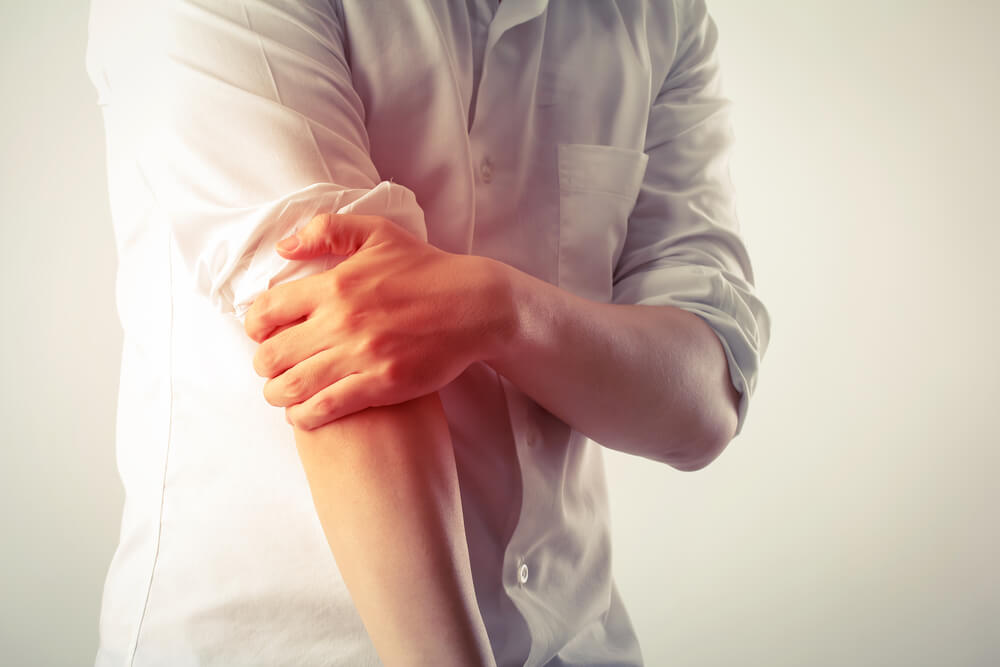We use our arms every day for the majority of daily tasks. When you have elbow pain when straightening your arm, it can be difficult to perform routine activities like reaching over your head, carrying grocery bags or putting on clothes. As a result, elbow pain can restrict your activity level and limit your quality of life. If you experience elbow pain when straightening your arm, your pain may also come with the following symptoms:
- Stiffness.
- Tenderness.
- Tingling.
- A burning sensation.
- Redness or a bump around the joint.
There are several reasons you may have elbow pain when straightening your arm. Pinpointing the reasons behind your elbow pain can help you find effective treatment for your specific symptoms. Physical therapists can help you identify the cause of your loss of mobility and pain and design a treatment plan accordingly.
5 reasons you may have elbow pain when straightening your arm
If you feel elbow pain when straightening your arm, you could be experiencing signs of a variety of conditions and injuries, ranging from arthritis to tendinitis. Your specific symptoms can help you identify the cause of your pain, which may be any of the following:
- Tennis elbow — Tennis elbow refers to the inflammation of the tendon that attaches your elbow bone to the muscles that control your wrist and fingers. Overuse or overexertion of the elbow during physical activities, such as swinging a tennis racket, can irritate this tendon and cause it to become inflamed. The result is a burning sensation and sensitivity when trying to straighten or bend your elbow.
- Bursitis — Bursitis refers to the inflammation of the bursae, which are tiny sacs of fluid found in your joints. The bursae prevent your tendons from rubbing against your bones and muscles, but overuse and overexertion of your elbow can cause the bursae to become inflamed. This causes swelling and tenderness that can limit your ability to bend or straighten your elbow.
- Bicep tendinitis — Bicep tendinitis involves the inflammation of your bicep tendon, which connects your bicep muscle to the inside of your elbow joint. Overexerting your elbow by lifting heavy objects can cause irritation to this tendon, which can be felt when trying to straighten or bend your elbow. It’s also possible for this tendon to completely rupture, which may cause intense pain. It can be identified by swelling and bruising where the bicep connects with the elbow.
- Dislocation — While rare, your elbow pain may be the result of a dislocation. The elbow joint is difficult to dislocate, but it can be possible to dislocate it if you fall on your arm while it’s extended, which can twist and force your elbow out of its place. When this happens, it can be incredibly painful to try to bend or straighten your elbow. You may notice swelling, bruising and a deformed appearance with this injury, so it’s usually clear if a dislocation is the source of your pain.
- Osteoarthritis — There are several types of arthritis, and osteoarthritis is the most common form that can affect the elbow. This form of arthritis is frequently caused by the natural wearing of cartilage in your joints as you age. With less cartilage, your elbow joint moves with less cushioning between the bones and can become stiff, making it difficult to straighten your arm. Elbow injuries can increase your chances of developing elbow osteoarthritis. Studies show that physical therapy can be effective in reducing osteoarthritis symptoms, including in the elbow.
How can physical therapy help you straighten your elbow without pain?
No matter the cause of your elbow pain, constant elbow pain every time you straighten your arm can be frustrating. Thankfully, physical therapy can help limit your elbow pain and help you get back to the activities you love. During a physical therapy session, your physical therapist may:
- Work with your doctor and other medical professionals.
Physical therapists often communicate directly with your doctor to determine an effective and safe treatment plan. Your doctor may also provide your physical therapist with imaging results, such as from an MRI, to help them better understand your injury and any musculoskeletal concerns they may have. - Perform manual therapy techniques like soft tissue mobilization.
In addition to guiding you through range-of-motion exercises, your physical therapist may use their hands to apply consistent pressure to the tissue surrounding your elbow. Doing so can release tension in your elbow and calm inflammation. - Introduce you to at-home exercises.
Your in-clinic exercises are important during physical therapy sessions, but continuing those exercises at home can help you fast-track your healing process and reduce your pain. Your physical therapist may teach you exercises that you can easily replicate at home.
Visit Advent Physical Therapy for elbow pain treatment
Are you having trouble moving your arm because of elbow pain? Our physical therapists at Advent PT are highly skilled in treatments designed to reduce elbow pain and improve your range of motion, so you can start regaining the use of your arm.
Contact our team today for more information about elbow pain treatment or to schedule an initial appointment.
